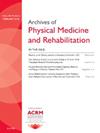Cross-disciplinary study of the neural basis of rehabilitation outcomes with virtual reality: a preliminary investigation
IF 3.6
2区 医学
Q1 REHABILITATION
Archives of physical medicine and rehabilitation
Pub Date : 2025-05-01
DOI:10.1016/j.apmr.2025.03.022
引用次数: 0
Abstract
Virtual Reality (VR) is increasingly gaining traction as an innovative solution to enhance rehabilitation outcomes by providing a conducive environment for engaging and customizable physical activity. To harness the benefits of such technologies, it is imperative to understand their interaction at the neural level. Therefore, as a first step, we utilized Electroencephalography (EEG) to investigate the spatiotemporal dynamics of the brain in young adults with and without VR immersion. Five healthy young adults (4 males) performed boxing exercises guided by either a 3D VR-based game or an instructional video displayed on a 2D computer screen. A 64-channel EEG was recorded during 3 graded task intensity levels: (i) rest, (ii) moderate, and (iii) advanced. We calculated the mean power spectral density in the 20-100 Hz range as a proxy to the level of activation for each EEG channel. Median cortical activation in each pre-frontal, frontal, parietal, and occipital region increased in proportion to task intensity, both with and without VR. The overall cortical activation was higher with VR versus instructional video for advanced-intensity tasks (p<0.001). Higher cortical activation indicates an underlying ion flow gradient for synaptic transmission, suggesting some neuroplastic changes during VR immersion. In this presentation, we will cover the implications of emerging results from the ongoing pilot randomized crossover study. We will discuss the rational for methodologies that combine VR headsets and EEG and our choice of outcome measures. This line of research holds significant potential to explain the effectiveness of VR and facilitate rehabilitation research and clinical translation.
虚拟现实康复结果的神经基础的跨学科研究:初步调查
虚拟现实(VR)作为一种创新的解决方案,通过为有吸引力和可定制的身体活动提供有利的环境,来提高康复效果,正日益受到关注。为了利用这些技术的好处,必须了解它们在神经水平上的相互作用。因此,作为第一步,我们利用脑电图(EEG)来研究有和没有VR沉浸的年轻人大脑的时空动态。五名健康的年轻人(4名男性)在3D vr游戏或2D电脑屏幕上显示的教学视频的指导下进行拳击练习。在3个分级的任务强度水平(i)休息、(ii)中度和(iii)高级时记录64通道脑电图。我们计算了20-100 Hz范围内的平均功率谱密度,作为每个EEG通道激活水平的代理。在有或没有VR的情况下,每个前额叶、额叶、顶叶和枕叶区域的正中皮质激活都与任务强度成比例地增加。在高强度任务中,与教学视频相比,VR的总体皮质激活更高(p<0.001)。较高的皮质激活表明突触传递的潜在离子流梯度,表明VR浸泡期间存在一些神经可塑性变化。在本报告中,我们将介绍正在进行的随机交叉试验的新结果的含义。我们将讨论结合VR头显和EEG的方法的合理性以及我们对结果测量的选择。这条研究线具有解释VR有效性和促进康复研究和临床翻译的巨大潜力。
本文章由计算机程序翻译,如有差异,请以英文原文为准。
求助全文
约1分钟内获得全文
求助全文
来源期刊
CiteScore
6.20
自引率
4.70%
发文量
495
审稿时长
38 days
期刊介绍:
The Archives of Physical Medicine and Rehabilitation publishes original, peer-reviewed research and clinical reports on important trends and developments in physical medicine and rehabilitation and related fields. This international journal brings researchers and clinicians authoritative information on the therapeutic utilization of physical, behavioral and pharmaceutical agents in providing comprehensive care for individuals with chronic illness and disabilities.
Archives began publication in 1920, publishes monthly, and is the official journal of the American Congress of Rehabilitation Medicine. Its papers are cited more often than any other rehabilitation journal.

 求助内容:
求助内容: 应助结果提醒方式:
应助结果提醒方式:


